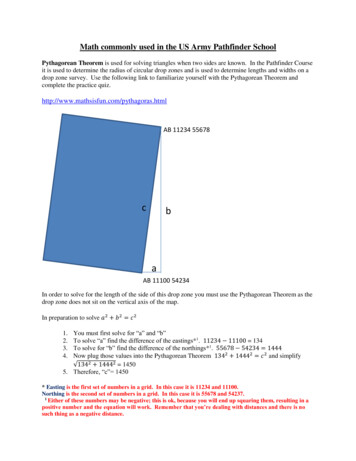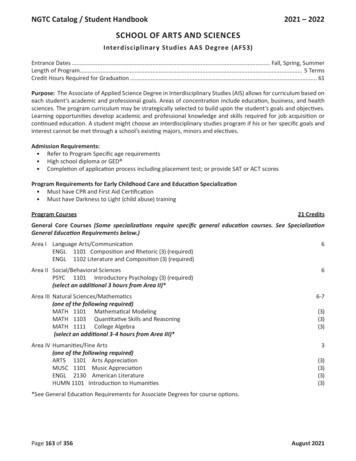
Transcription
Math commonly used in the US Army Pathfinder SchoolPythagorean Theorem is used for solving triangles when two sides are known. In the Pathfinder Courseit is used to determine the radius of circular drop zones and is used to determine lengths and widths on adrop zone survey. Use the following link to familiarize yourself with the Pythagorean Theorem andcomplete the practice quiz.http://www.mathsisfun.com/pythagoras.htmlAB 11234 55678cbaAB 11100 54234In order to solve for the length of the side of this drop zone you must use the Pythagorean Theorem as thedrop zone does not sit on the vertical axis of the map.In preparation to solve 𝑎2 𝑏 2 𝑐 2You must first solve for “a” and “b”To solve “a” find the difference of the eastings*1. 11234 11100 134To solve for “b” find the difference of the northings*1. 55678 54234 1444Now plug those values into the Pythagorean Theorem 1342 14442 𝑐 2 and simplify 1342 14442 14505. Therefore, “c” 14501.2.3.4.* Easting is the first set of numbers in a grid. In this case it is 11234 and 11100.Northing is the second set of numbers in a grid. In this case it is 55678 and 54237.1Either of these numbers may be negative; this is ok, because you will end up squaring them, resulting in apositive number and the equation will work. Remember that you’re dealing with distances and there is nosuch thing as a negative distance.
BASICS OF A DROP ZONEThe left corner as you depart the dropzone on drop heading is known as theLeft Trailing Edge (LTE)The right corner as you approach thedrop zone on drop heading is knownas the Right Trailing Edge (RTE)This distance is known as the WIDTHor the LATERAL WIDTH.Direction of FlightThis distance is known as the LENGTHor the LONGITUDINAL LENGTH.This distance is known as theDIAGONAL LENGTH or theDIAGONAL AND LONGITUDINALLENGTH.The left corner as you approach thedrop zone on drop heading is knownas the Left Leading Edge (LLE)The right corner as you approach thedrop zone on drop heading is knownas the Right Leading Edge (RLE)
Dimensions of a drop zone (always round your final answers down):Length - Compare both lengths (left side [LLE to LTE] and right side[RLE to RTE]) and takethe SMALLEST value.Width – Compare both widths (lead edge [LLE to RLE] and trail edge [LTE to RTE]) and takethe SMALLEST value.Diagonal Length – Compare both diagonals (RLE to LTE and LLE to RTE) and take theSMALLEST value.2To convert meters to yards divide by .9144 (100 meters .9144 109.36 yards)2To convert yards to meters multiply by .9144 (100 yards x .9144 91.44 meters)When converting, do not round until AFTER you have completed the conversion.Ex. Convert 789.8 m to yds789.8 m .9144 863.736 yds. Round both answers down – 789m / 863 ydsIf you INCORRECTLY round meters down before converting789 m .9144 862.861 yds. Round down and it is 789 m / 862 yds – This answer is 1yd offand therefore wrong.PRACTICE QUESTIONS (ANSWER IN METERS AND YARDS)1. You have a drop zone with the following corner coordinates:Left Leading Edge (LLE) - 18S TH 92110 26839Right Leading Edge (RLE) - 18S TH 91337 26350Left Trailing Edge (LTE) – 18S TH 92941 25525Right Trailing Edge (RTE) – 18S TH 92168 25036a) What is the length of the drop zone?b) What is the width of the of the drop zone?c) What is the diagonal length of the drop zone?
2. You have a drop zone with the following corner coordinates:Left Leading Edge (LLE) - 16R EU 70649 96816Right Leading Edge (RLE) – 16R EU 70471 97430Left Trailing Edge (LTE) – 16R EU 68893 96306Right Trailing Edge (RTE) – 18S EU 68715 96920a) What is the length of the drop zone?b) What is the width of the of the drop zone?c) What is the diagonal length of the drop zone?3. You have a drop zone with the following corner coordinates:Left Leading Edge (LLE) - 06V UP 58937 05981Right Leading Edge (RLE) – 06V UP 57307 06202Left Trailing Edge (LTE) – 06V UP 58593 03444Right Trailing Edge (RTE) – 06V UP 56963 03665a) What is the length of the drop zone?b) What is the width of the of the drop zone?c) What is the diagonal length of the drop zone?ANSWERS1. a) 1554m / 1,700yds2. a) 1828m / 1999yds3. a) 2560m / 2799ydsb) 914m / 1,000ydsb) 639m / 699ydsb) 1644m / 1798ydsc) 1803m / 1972ydsc) 1937m / 2118ydsc) 3043m / 3327yds
The Law of Sines (or Sine Rule) is used to determine the unknown lengths of a triangle when you haveone known side and known angles. In the Pathfinder Course it is used to determine width and lengthrequirements of helicopter landing zones and angular drift calculations on drop zones. Use the followinglink to familiarize yourself with the Law of Sines and complete the practice law.html200mIn order to determine the forward and/or lateral drift distances we must use the “Law of Sines”aCBcbA
a50ᴼ90ᴼWhere:200mb40ᴼ𝑎𝑆𝑖𝑛 40𝑏200 𝑆𝑖𝑛 50 𝑆𝑖𝑛 90To solve for side “a”: a 200(Sin 40)a 129m: b 200(Sin50)b 153m*Sin 90 1WHEN USING THE LAW OF SINES, ALWAYS USE “PROPER” MATH ROUNDING –BELOW 5, ROUND DOWN; 5 AND ABOVE, ROUND UP.
PRACTICE QUESTIONSSolve for “a” and “b”, answers are in metersb1.54 90 a b 𝑎𝑆𝑖𝑛 𝐴𝑏𝑐 𝑆𝑖𝑛𝐵 𝑆𝑖𝑛𝐶a371m36 Solve for “a” and “b”, answers are in meters2.a bb 𝑎𝑆𝑖𝑛 𝐴𝑏𝑐b17 90 𝑆𝑖𝑛𝐵 𝑆𝑖𝑛𝐶aa263m73
Solve for “a” and “b”, answers are in metersb3.41 90 a b 𝑎𝑆𝑖𝑛 𝐴𝑏𝑐 𝑆𝑖𝑛𝐵 𝑆𝑖𝑛𝐶a153m49 ANSWERS1. a)2. a)3. a)218m77m100mb)b)b)300m252m115m
Incoming students also need to know:2To convert meters to yards divide by .9144 (100 meters / .9144 109.36 yards)2To convert yards to meters multiply by .9144 (100 yards x .9144 91.44 meters)To convert feet to meters divide by 3.28 (10 feet / 3.28 3.05 meters)To convert meters to feet multiply by 3.28 (3 meters x 3.28 9.84 feet)Aircraft Rate – to convert airspeed (KIAS – knots indicated airspeed) into meters/sec, multiplyby .51 (70 KIAS x .51 35.7 meters per second) Depending on the problem, you may need toround this value up.When doing conversions from meters to yards, remember that your “meters” value should ALWAYS BESMALLER than your “yards” value.2Radius – ½ the Diameter of a circleDiameter – the width of a circle as it passes directly through the centerMath SymbolsX Y - X is greater than YX Y - X is less than YX Y - X is greater than or equal to YX Y - X is less than or equal to Y
1. You must first solve for "a" and "b" 2. To solve "a" find the difference of the eastings*1. 11234 11100 134 3. To solve for "b" find the difference of the northings*1. 55678 54234 1444 4. Now.











